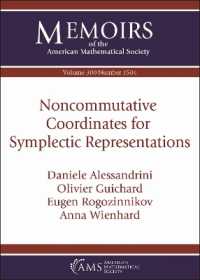- ホーム
- > 洋書
- > 英文書
- > History / World
Full Description
A Primer for Teaching Digital History is a guide for college and high school teachers who are teaching digital history for the first time or for experienced teachers who want to reinvigorate their pedagogy. It can also serve those who are training future teachers to prepare their own syllabi, as well as teachers who want to incorporate digital history into their history courses. Offering design principles for approaching digital history that represent the possibilities that digital research and scholarship can take, Jennifer Guiliano outlines potential strategies and methods for building syllabi and curricula. Taking readers through the process of selecting data, identifying learning outcomes, and determining which tools students will use in the classroom, Guiliano outlines popular research methods including digital source criticism, text analysis, and visualization. She also discusses digital archives, exhibits, and collections as well as audiovisual and mixed-media narratives such as short documentaries, podcasts, and multimodal storytelling. Throughout, Guiliano illuminates how digital history can enhance understandings of not just what histories are told but how they are told and who has access to them.
Contents
Acknowledgments ix
Introduction 1
Part I. Foundations
1. Sources as Data 19
2. Learning Outcomes 35
3. New Forms of Assignments 53
4. The Basics of Digital Methods 71
Part II. Selected Methods
5. Digital Source Criticism 85
6. Text and Network Analysis 97
7. Visualization 111
Part III. Forms of Scholarship
8. Digital Archives, Digital Exhibits, and Digital Collections 129
9. Storytelling 149
10. Crowdsourcing 163
Conclusion: Embracing Digital History 171
Glossary 179
Notes 201
Bibliography 221
Index 243








